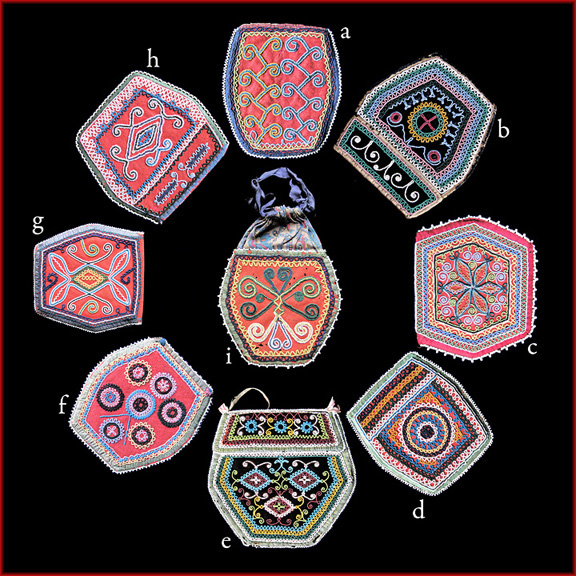In the centuries before the introduction of the souvenir purse, Iroquois bags that were made on hide and for personal use were ornamented almost exclusively with porcupine quills or moosehair. These pouches were an essential article since traditional apparel had no pockets. Surface decorations sometimes represented a guardian spirit, whose design was derived from a dream or visionary experience. Many were decorated with geometric patterns while others incorporated human or animal motifs in the ornamentation. The pouches were used primarily to carry sacred medicines, ritual objects, and articles for hunting, warfare or personal effects. Many of the linear and geometric designs we see on these bags were carried over to the earliest souvenir bags on cloth. It’s not until about 1830 that floral decorations became prevalent on souvenir bags.
Exactly when the Haudenosaunee began selling souvenir beadwork is debatable. Certainly it did not begin until after the end of the Revolutionary War (1783) and there are a few dated examples that suggest the trade in souvenir beaded bags emerged around the turn of the nineteenth century.
The fundamental characteristics of these early souvenir bags are that they were often hexagonal in shape and they had intricate linear designs that were well-organized and logically-constructed. This could be a carryover from the way these skilled artists were accustomed to working with porcupine quills – a technique which leant itself to linear work. Their designs included large areas of negative space. The decorations often incorporated symbols like the double-curve, heart, diamond, sun with equal-armed cross, and a host of other organic motifs. Bags from this period (1800-1830) had few if any areas that were solidly filled with beads. The beads were usually sewn onto wool broadcloth that was either red or black. The edge binding was almost always silk and often in green, red or blue though other colors were occasionally used. There was usually a two-bead edging, sometimes called a zippered edging or a chain stitch, along the outside of the bag and there are variations of this stitch as well.
The bag at position (b) came with a period note indicating it was collected in 1797. There is a similar bag in the New York State museum that was collected in 1807 by Dennis Doyle, a merchant from New York City who was in Albany for the inaugural launch of Robert Fulton’s steamboat the Clermont. When this piece was donated to the museum in 1964, there had not been any research done on souvenir beadwork. This may account for the Mahikan (?) with the question mark attribution, [more commonly spelled Mahican or Mohican and not to be confused with Mohegan, from southern Connecticut]. The attribution in the museum’s documentation contains the question mark, which means whoever recorded the tribal affiliation wasn’t sure who made it and was offering a best guess. The hexagonal shape and internal design motifs are more typical of early bags attributed to the Seneca or Tuscarora.
The bag at position (d) had several sheets of an old newspaper – between the bag face and the inside lining – that was used to stiffen it during construction. It was from an 1822 edition. The extended top on the bag in position (i) is feature that is often seen on early ladies reticules or drawstring handbags. None of these bags have any areas of solid bead fill in the design. The work is all linear.
